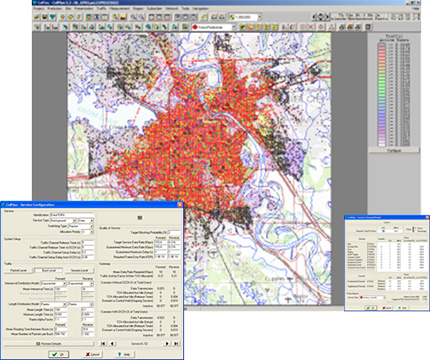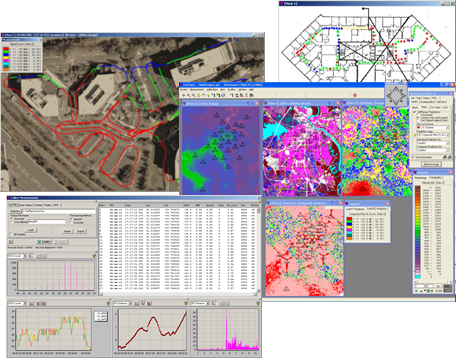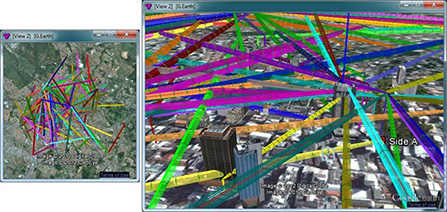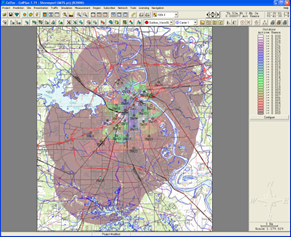CellDesigner™
Software for Planning & Designing Wireless Communication Systems
 CellDesigner™ is a next generation RF planning and optimization tool that is based on customer experience parameters and provides reliable/long lasting network optimization. It has enhanced 3D-RF predictions, multiple service classes, statistical SNR availability, customer experience considerations. It is an ideal companion for SON-based solutions. CellDesigner™ is a next generation RF planning and optimization tool that is based on customer experience parameters and provides reliable/long lasting network optimization. It has enhanced 3D-RF predictions, multiple service classes, statistical SNR availability, customer experience considerations. It is an ideal companion for SON-based solutions.
Multi-Technology Support
The tool supports all wireless technology standards, including but not limited to LTE –A (TDD and FDD), WiMAX, WI-FI, WCDMA (UMTS), HSPA, HSPA+, IS2000 (1xRTT, EVDO), GSM (including Frequency Hoping), GPRS, EDGE, EDGE-E, CDMA One, PMR/LMR (Tetra and P25), MMDS/LMDS, DVB-T/H, and Wireless Backhaul.
CellDesigner has fully implemented the Korowajczuk 3D model, capable of performing simultaneously outdoor and indoor multi-floor predictions.
Automatic Frequency Planning (AFP)
CellDesigner™ features an automatic resource-planning tool that utilizes sophisticated statistical algorithms to allow the user to dramatically increase the network capacity and performance. It automatically and efficiently optimizes hand-off thresholds, neighbor lists, and frequency plans. It also offers optimization of several CDMA network parameters. It is the only tool in the industry that allows sequential layers of optimization and geographic performance analysis for the entire network. CelPlan has developed a new methodology (patent pending) based on cell interference regions, capable of increasing significantly cell capacity and ideal to be used in conjunction with SON and ICIC.
Automatic Cell Planning (ACP)
Additionally, CellDesigner™ is also capable of automatically shaping cell footprints to simultaneously minimize interference (considering diversity effects), while maintaining the same coverage, and balancing traffic.
It also allows optimization of radiated power, antenna type, tilt, azimuth, and height. Users can specify parameters changes for each sector, their relative priority, and the acceptable value range for each modification.
CellDesigner™ allows minimization of system resources usage without affecting the quality of the existing system. This is achieved by reducing the hardware required to carry same amount of traffic, by reducing the network overhead for soft hand-off without increasing system load, and by reducing the total transmission power required in the downlink.
For systems using multiple frequency channels, CellDesigner™ allows users to optimize cell footprints considering the frequency plan or not. This makes the tool extremely flexible as it offers carriers the opportunity of re-defining physical parameters of sites before or after making changes on the frequency plan.
Google Earth Integration
CellDesigner™ integrates Google Earth into it, so it is capable of presenting the predictions and measurements live in the 3D environment.
Network Master Plan (NMP)
CelPlan has developed a methodology that simplifies SON and ICIC procedures (patent pending). We are talking to vendors and operators that are willing to benefit from this solution.
Integration of Field Measurement Data
 CellDesigner™ can be configured to collect data from virtually all types of measurement equipment, from general spectrum analyzers to specialized vendors’ equipment, and it also features CelPlan’s exclusive Hyper Windows, allowing engineers to open multiple, synchronized windows for easy analysis of various types of information. CellDesigner™ can be configured to collect data from virtually all types of measurement equipment, from general spectrum analyzers to specialized vendors’ equipment, and it also features CelPlan’s exclusive Hyper Windows, allowing engineers to open multiple, synchronized windows for easy analysis of various types of information.
- Conversion of measurements from any format
- Application of GPS correction (differential) for measurements in places where service is unavailable
- Application of GPS interpolation
- Filtering by frequency, signal level (with or without a grid reference), distance sampling frequency, and time
- Filtering by geographic area, morphology type, or obstruction
- Appending files
- Automatically extracting the propagation parameter with our unique EXTRACT software for any of our models (optimized Lee-Picquenard, Korowajczuk, microcell, or LOS)
- Display of measurements graphically by distance or acquisition order and visualization of them geographically
- Performance of statistical analysis of measurements for measurement quality, database dispersion, prediction deviation, and prediction error
GIS Database Editor
CellDesigner™ also includes a powerful GIS database editor that allows users to edit and process geographical databases. A set of specialized applications is included in the tool, providing users with resources to handle and modify imagery, topographical, and morphological data.
Backhaul Planning
CellDesigner™ also calculates network interconnections, interference analysis & reporting for point-to-point, microwave transmission links. It implements all of the 3GPP specifications and integrates fully with Google Earth, presenting the Fresnel zone in 3D.
 Single point-to-point links can be designed considering terrain, clutter, tower heights, and multiple-knife diffraction. CellDesigner™ can display obstruction in Fresnel zones as well as the path loss. Tower height requirements are automatically displayed for each configuration. A database of all other existing links can be assembled on a regional or national basis. Single point-to-point links can be designed considering terrain, clutter, tower heights, and multiple-knife diffraction. CellDesigner™ can display obstruction in Fresnel zones as well as the path loss. Tower height requirements are automatically displayed for each configuration. A database of all other existing links can be assembled on a regional or national basis.
For lower frequencies, CellDesigner™ uses the Picquenard method (also known as the Deygout model) to calculate the attenuation caused by diffraction. After the diffraction situation is determined, a user can analyze other parameters that determine the unavailability objectives established to meet the ITU-R quality standards of this link. For frequencies over 10 GHz, CellDesigner™ can calculate rain attenuation for each link and then analyze additional parameters.
The software utilizes link data, such as topography, morphology, images, equipment specifications, and climatic features of the region, to provide the results of performance of the link and compare results with the requirements established by ITU-R.
Users can consider basic types of channel arrangements found in radio transmission systems: co-polar, cross-polar, and co-channel. For each of these cases, CellDesigner™ determines the degradation caused by the interference on a useful channel. Finally, in performance calculations, users can include improvement factors due to the existence of counter measurement devices in the system, such as equalizers, coders, and diversities (space, frequency, and space and frequency).
Main Features
- Integrated GIS Platform
- Simultaneous multi-resolution 3D models for topography and morphology
- Morphology height defined in a pixel basis
- Multiple image layers
- Regions and sub-regions with attributes
- Multi-layered traffic information
Accurate Propagation Models
- Multi morphology considered for each path.
- RF propagation parameters calibration per morphology
- Increases the re-usability of the propagation parameters throughout the design area.
- This calibration per morphology approach requires significantly less drive test data then traditional calibration methods.
- Highest propagation parameters reuse in the industry, which allows modeling of markets even when no drive test data is available.
- CelPlan's unique K models (K2D and K3D) provide the best results in the industry for the wide range of applications of today's wireless systems.
- These models take full advantage of higher resolution databases even when detailed building height information is not present.
- Classical propagation models such as Lee, Okumura-Hata, Cost 231 are also implemented in CellDesigner™ to allow users to model networks even when higher resolution GIS is not available.
- A five-intercept microcell model, the Stanford University Interim model, LOS, TCA, and ITU-R P.1812/1546 are also available for specialized designs.
Propagation Analysis
- Supports True Large Scale (5,000+ sites) modeling
- Simultaneous propagation analysis for multiple floors (multi level analysis)
- Automatic calculation of service coverage area based on service requirements
- Comprehensive Data Service Class modeling
- Switch data, measured data or prediction-based Interference Matrix generation
- Integrated backhaul planning and link analysis
- Unique Network Performance and QoS report generation
- Fading predicted on a pixel basis
- Predictions for downlink and uplink
- In-building RF modeling
- Fractional Morphology
- Multiple morphologies are considered in each link
- All morphologies across propagation path are relevant to analysis
Reporting and Plotting Best output in the industry
- The translucent feature allows the display and plotting of background and foreground information one on top of the other, avoiding clumsy usage of multiple sheets of transparent paper
- Print preview feature
- Automatic selection of paper for a specified scale or vice-versa for improved effectiveness
- Interface with Office Information Systems to increase efficiency on engineering operations
Enhanced Traffic and Demographic Analysis
 Geographic traffic layers generation from demographic data Geographic traffic layers generation from demographic data- Geographic traffic layers generation from switch data
- Multi layer traffic analysis (residential, vehicular, business, commercial, special events, voice, data, etc.)
- Complete load simulation utilizing Monte Carlo techniques considering downlink and uplink with power control support
- Automatic capacity planning based on demand and service coverage analysis
- This capability is an essential tool for the marketing department of an operating company, because the system's goals can be precisely specified, verified, and corrected prior to actual deployment of equipment
- Complete demographic analysis per service offering type
Neighborhood Analysis
- Automatic neighbor lists generation
- Handover thresholds calculation
- Handover thresholds calculation
Advanced Relationship Matrix
- Multiple inputs can be used independently or combined:
- Prediction data
- Switch data
- Drive test data
- Sector-To-Sector relationship is calculated
- Traffic weighted analysis
- Mobility / Priority geographic regions
- Power control and fading calculations
- Consideration of the effects of subscribers on multi-story buildings
Automatic Resources Planning
- Multiple technology support
- Resource blocking by system or by sector
- Variable reuse pattern
- Full frequency hoping support
- Multiple-layer resource planning (carriers, color codes, offset indexes)
- Automatic gain consideration for: Frequency diversity
- Interference diversity
- DTX
- Fractional loading (per sector analysis)
- Support for MRP (Multiple Reuse Pattern)
- Multiple technology support
- Resource blocking by system or by sector
- Variable reuse pattern
- Full frequency hoping support
- Multiple-layer resource planning (carriers, color codes, offset indexes)
- Automatic gain consideration for: Frequency diversity
- Interference diversity
- DTX
- Fractional loading (per sector analysis)
- Support for MRP (Multiple Reuse Pattern)
Platform and Network Features
- Native Windows support
- Compatible with Windows 2003/2008 Server or Windows7 or XP
- Centralized or distributed databases
- Centralized or distributed projects
- Centralized or distributed predictions
- Remote server operation (RemoteControl)
- Field access to data (RemoteAccess)
- Operation with compressed files
HIGHLIGHTS
Complete Software Solution
- Internal specialized GIS and RDB
- Enhanced demographic and traffic generation and analysis
- Multi-technology support
- Fixed and mobile subscribers support
- Integrated microwave links design
Unprecedented Accuracy
- Prediction models that consider multi-morphologies in each path
- Unique automatic calibration engine
- Predictions performed to various subscriber heights
- Downlink and uplink power control
Unsurpassed Performance
- Advanced user interface
- Scalable to support even the largest wireless networks
- Optimized processing times
- Native Windows OS support
- Fully networkable
ROI Improvements
- CAPEX
- Real life predictions and traffic considerations provide efficient designs
- Multi scenario analysis capability
- Minimization in the requirements of new site design
- Better usage of existing infrastructure
- OPEX
- Much less system interventions due to adequate planning
- No post deployment retuning
- Minimization of drive tests expenses
- Shorter time to market
- More effective use of engineering teams
SALES Churn reduction
- New users' attraction due to better quality
- More attractive pricing due to reduced OPEXack to T
|